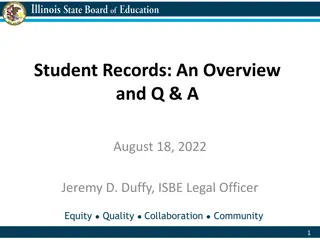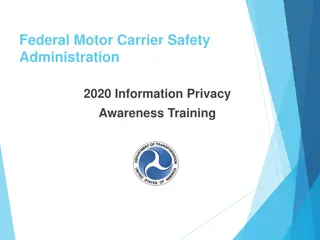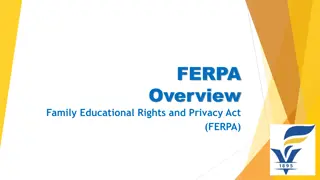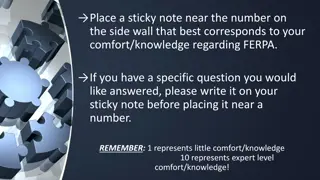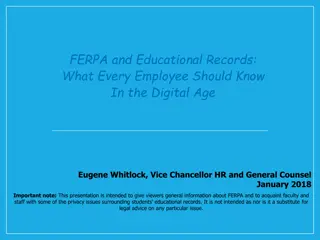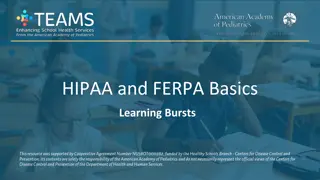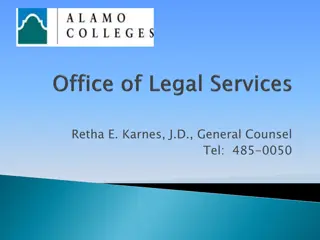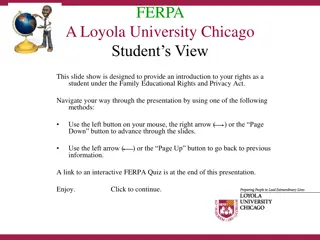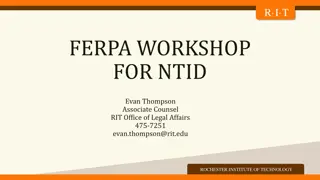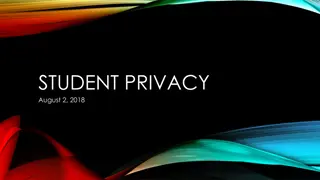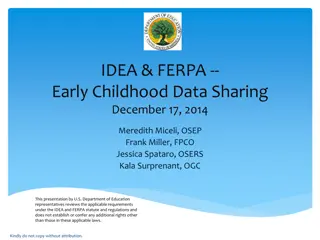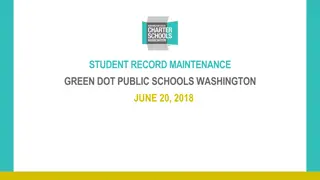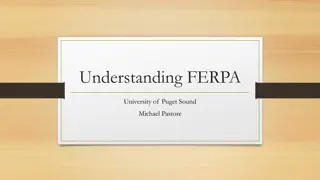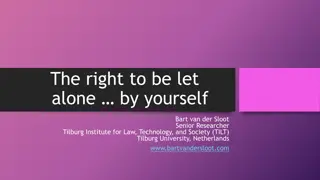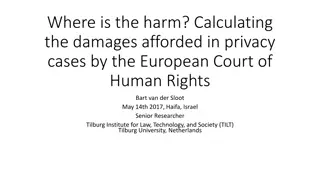Understanding FERPA: Family Educational Rights and Privacy Act Explained
FERPA, the Family Educational Rights and Privacy Act, is a federal law safeguarding the privacy of student education records. It grants parents and eligible students certain rights, including access to and amendment of records. Schools must have permission to release information from a student's record, except in specific situations outlined by FERPA.
Download Presentation

Please find below an Image/Link to download the presentation.
The content on the website is provided AS IS for your information and personal use only. It may not be sold, licensed, or shared on other websites without obtaining consent from the author. Download presentation by click this link. If you encounter any issues during the download, it is possible that the publisher has removed the file from their server.
E N D
Presentation Transcript
Special Education Special Education Professional Development Professional Development Training Training I. Confidentiality II. ADHD III. Response to Intervention IV. Problem Solving Teams (PST) V. Special Education Process
Confidentiality Confidentiality
Family Educational Rights and Privacy Act (FERPA) The Family Educational Rights and Privacy Act (FERPA) (20 U.S.C. 1232g; 34 CFR Part 99) is a Federal law that protects the privacy of student education records. The law applies to all schools that receive funds under an applicable program of the U.S. Department of Education.
FERPA (continued) FERPA gives parents certain rights with respect to their children's education records. These rights transfer to the student when he or she reaches the age of 18 or attends a school beyond the high school level. Students to whom the rights have transferred are "eligible students."
Provision of Copy of Records Parents or eligible students have the right to inspect and review the student's education records maintained by the school. Schools are not required to provide copies of records unless, for reasons such as great distance, it is impossible for parents or eligible students to review the records. Schools may charge a fee for copies.
Amendment of Records at Parent s Request Parents or eligible students have the right to request that a school correct records which they believe to be inaccurate or misleading. If the school decides not to amend the record, the parent or eligible student then has the right to a formal hearing. After the hearing, if the school still decides not to amend the record, the parent or eligible student has the right to place a statement with the record setting forth his or her view about the contested information.
Release of Information Generally, schools must have written permission from the parent or eligible student in order to release any information from a student's education record. However, FERPA allows schools to disclose those records, without consent, to the following parties or under the following conditions (34 CFR 99.31):
Parties/Situations Needing No Consent School officials with legitimate educational interest; Other schools to which a student is transferring; Specified officials for audit or evaluation purposes; Appropriate parties in connection with financial aid to a student; Organizations conducting certain studies for or on behalf of the school; Accrediting organizations; To comply with a judicial order or lawfully issued subpoena; Appropriate officials in cases of health and safety emergencies; and State and local authorities, within a juvenile justice system, pursuant to specific State law.
Directory Information Schools may disclose, without consent, "directory" information such as a student's name, address, telephone number, date and place of birth, honors and awards, and dates of attendance. However, schools must tell parents and eligible students about directory information and allow parents and eligible students a reasonable amount of time to request that the school not disclose directory information about them. Schools must notify parents and eligible students annually of their rights under FERPA. The actual means of notification (special letter, inclusion in a PTO bulletin, student handbook, or newspaper article) is left to the discretion of each school.
Resource For additional information or technical assistance, you may call (202) 260-3887 (voice). Individuals who use TDD may call the Federal Information Relay Service at 1-800-877-8339. U.S. Department of Education
Confidentiality Agreement Please print out the Confidentiality Agreement at the end of this presentation. Sign the Confidentiality Agreement and turn in to your SPED Lead Teacher s box or to the Special Education Coordinator. One MUST be signed by each employee each year. Each Shelby County Board of Education Employee must sign a form each year (i.e., bus drivers, counselor, etc) Any visitors (college students, agency, etc) must sign this form as well prior to observing in a class.
Destruction of Records All of the students special education records are to be maintained until the student exits the school system. Once the student exits, the records are to be maintained for five years. At all times, records are to be kept in a locked area and kept confidential. Once the records have been maintained for the five-year period, contact the Special Services Center for the procedure to destroy the records. Records may not be destroyed without parent notification and when destroyed, they must be burned or shredded.
ADHD Attention Deficit / Hyperactivity Disorder
Characteristics What is Attention Deficit / Hyperactivity Disorder (ADHD)? Attention Deficit / Hyperactivity Disorder is a neurological disorder. Students with ADHD demonstrate significant impairment related to inattention and/or hyperactivity and impulsivity compared to average children of the same age.
Diagnostic Criteria for ADHD The following symptoms are listed in the DSM-V and are used to diagnose ADHD. At least six of these symptoms must be displayed in a number of settings, persist over six months, and must have been observed prior to age seven in order for the diagnosis to be made.
Inattentive Symptoms Fails to give close attention to details or makes careless mistakes in school work or other related activities. Has difficulty sustaining attention in tasks or play activities. Does not seem to listen when spoken to directly Does not follow through on instructions and fails to finish schoolwork, chores, or duties Has difficulty organizing tasks and activities
Inattentive Symptoms (Contd) Avoids, dislikes, or reluctant to engage in tasks that require sustained mental effort Loses things necessary for tasks and activities Is easily distracted by extraneous stimuli that are usually easily ignored by others Forgetful in daily activities
Hyperactivity Symptoms Leaves seat in classroom or in other situations in which remaining seated is expected. Runs about or climbs excessively in situations in which it is inappropriate Has difficulty playing or engaging in leisure activities quietly Is on the go or acts as if driven by a motor Talks excessively
Impulsivity Symptoms Blurts out answers before questions have been completed Has difficulty awaiting turn Interrupts or intrudes on others
Identification Rate in Shelby County Lee vs. Macon made systems review eligibility of minority students in the categories of Intellectual Disability and Emotional Disability because of overrepresentation. Since that time, the number of students has increased in the area of Other Health Impairment (OHI), specifically in the area of inattention.
Accommodations Various accommodations can be utilized by all teachers for students with deficits in attending. Many of these accommodations can be used at all levels of Response to Intervention (RtI) {Tier 1, Tier 2, and Tier 3}.
Getting Students Attention Use storytelling Clearly signal: Everybody Ready Model excitement and enthusiasm about the upcoming lesson Use eye contact (students should be facing you, especially when direct instructions are given) Color is very effective in getting attention. May use color to highlight key terms. Use visual signals Vary your tone of voice: loud, soft, whisper Signal students auditorily: ring a bell, use a timer, play music Theatrics may spark an interest
Focus Students Attention Use a laser pointer Use visuals (pictures, diagrams, manipulatives) Ask students to illustrate key points Use cloze method (class notes with key terms missing) Explain the purpose and relevance of your lesson Project your voice to be heard clearly by students Be aware of competing sounds in room (air conditioning, humming of fluorescent lights). Be aware that it is not that students are not focusing; they are focusing on EVERYTHING!!! Use hands-on presentations / demonstrations
Accommodations for Seat Work Seat student near a study buddy or a good role model Increase distance between desks Allow extra time to complete work Assist student in setting short-term goals Give clear, concise instructions Cue student to stay on task (private cue / signal) Pair written instructions with oral instructions Use contracts, charts, and BIPs for on-task behavior
Accommodations for Seat Work Give assignments one at a time to avoid work overload Chunking give assignments in smaller chunks Reduce amount of homework Use buff colored paper instead of white Take tests in a quiet environment Be aware of lighting can cause a glare on white paper
Maintaining Students Attention Move around the classroom to maintain your visibility Be PREPARED and avoid lag-time in instruction Use direct instruction techniques Use motivating games and computer programs for skill building and practice Use cooperative learning groups
Planning and Organization Provide organization rules Provide student with homework assignment book Supervise writing down of homework assignments MODEL planning and organization by your classroom and actions Send daily / weekly reports home (you can also set up a blog for the students and students parents to view daily) Allow students to have an extra set of books at home Encourage learning of keyboarding skills Do not penalize for poor handwriting if that is an area of concern Regularly check desk and notebook for neatness
Behavior Allow students to stand at times while working Supervise closely during transition times Praise appropriate behavior Prompt appropriate social behavior either verbally or with a private signal Praise compliant behavior (we know that students should be compliant at all times, but we know there are those who need encouraging!) Provide immediate feedback Ignore minor, inappropriate behavior (when acceptable) Acknowledge positive, appropriate behavior of nearby students Monitor social interactions Encourage cooperative learning tasks with other students Provide lessons on social skills
Remember Any person who does not recognize talents as well as weaknesses that make children with ADHD / ADD different, will find it difficult to be supportive. Alice Mae Smith
RTI Response to Intervention
Best Practices Individuals with Disabilities Education Act (IDEA) requires a research based program to be used in reading before identification. The goal of the Response to Intervention (RtI) model is to address deficits as soon as the interferences of learning are noticed instead of waiting for the students to fail. It is important to utilize the interventions in Tier Two to be able to correctly identify what program a student may need to remediate the deficit.
Alabama s RtI Framework ..\Desktop\Response to Intervention and Child Find.pdf
Problem Solving Teams (PST) An Overview
Questions ??? Screening questions 1. What are some examples of universal screeners? 2. What areas must be screened? 3. When do you screen?
Screening: What and When Screen basic math and reading skills For K-3 students, ALL students should be screened 3 times per year. For grade 4-12 students, schools could: Screen all students (as in K-3) screen all entering students complete a records review and then screen students below a designated level
System-wide intervention criteria School systems will need to determine the screening outcomes which will result in intervention consideration and referral to one of the problem solving teams. If score is below ___ then student will be reviewed by the appropriate problem solving team (PST) Could choose arbitrary percentile score Could choose score which predicts success on high stakes test like ACAP
Screening and Progress Monitoring Need to select a screening tool which also has some useful progress monitoring tools built into their package Progress should be monitored weekly Incorrect progress monitoring tool use is a deal breaker Shelby County s process: http://https://sites.google.com/shelbyed.org/scs-internal- forms/special-education-vision-hearing
Questions ??? Tier questions 1. Define Tier II and Tier III. 2. Who would be in Tier II? 3. Examples of class set-up for Tier II 4. Amount of intervention times for Tier II 5. Intervention strategies for Tier II 6. How long in Tier II before you move to Tier III? 7. What does Tier II look like? 8. How is Tier III different from activities in Tier II?
Elementary Tier Model (K-3) s t Tier 3 Plus ? % Special Education 5% Intensive Intervention 60 minutes Intervention 30 minutes per day in the classroom Tier 2 15% Comprehensive Core 90 minutes per day reading 60 minutes per day math Tier 1 80%
Academically, what should Tier 1 include for elementary students? MINIMUM of 90 minutes in reading and 60 minutes in math of uninterrupted core instruction NRP and NMAP suggest a combination of whole and small group differentiated instruction The five big ideas from the NRP and critical benchmarks from NMAP!
Tier 2 for elementary students. Additional small group instruction Best when provided by classroom teacher At least 10-12 weeks in duration** Frequent progress monitoring May need additional rounds of Tier 2 if adequate progress is being made May need to move to Tier 3 if inadequate progress is being made
Tier 3 for K-3 students Intensive intervention Does not replace or supplant (Tier 1) but may replace Tier 2 Designed to meet identified student needs in math, reading, and behavior Student will miss something Decide what will be missed Schedule for success! Who might provide this intervention? Title I; reading, math, or behavior interventionists; SPED; Para; Classroom teacher, etc
Grade 4-12 Tier Model Plus ? % Special Education 5% Tier 3 Intensive Intervention classes Differentiated strategy instruction in content classes small group-intentional groupings 15% Tier 2 Tier 1 80% Core instruction=Strategy instruction in content classes whole and small group
About Grades 4-12 Tier 1 Students learn how to learn Strategic teaching in ALL classes Some time for students to work with peers daily in ALL classes Encourages student engagement Students become active participants in the learning process Students make their own meaning
About Grades 4-12 Tier 2 Differentiated strategic teaching Teacher explicitly models strategies with students and scaffolds as needed Opportunities for peer-tutors and heterogeneous grouping (weaker with stronger and teacher rotates among groups) Opportunities for homogeneous grouping (weak come together and teacher works with that group)
About Grades 4-12 Tier 3 Intensive intervention classes for students who need them (math, reading, and behavior) Reading Word-level interventions and comprehension interventions Math Computation and problem solving interventions Behavior- small group sessions/classes Scheduling options Grade specific intervention times Acceleration block
Questions ??? Intervention strategies for Tier II
Some ideas from K-3 Intervention Research Scammacca, N., Vaughn, S., Roberts, G., Wanzek, J., & Torgesen, J. K. (2007). All of the effective Tier 2 interventions included training in: phonological awareness decoding, and word study guided and independent reading of progressively more difficult texts writing exercises engaging students in practicing comprehension strategies while reading text.
An intervention study illustrating effective Tier 2 options .
Early Interventions in Reading (Torgesen and Mathes, 2005) 120 lessons, 40 minutes, 3-5 students Mathes, et al 2005 study . Excellent gains after 91 hours of instruction Only 1% of the students were reading below the average range (30thpercentile)! Intervention students had steeper rates of improvement than typical readers on word reading, passage fluency, and phonological awareness. Published by SRA



